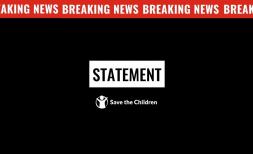Somalia’s worst drought crisis in a decade leaves millions hungry with lives at risk

Kayd*, Omar*'s son, and his siblings collect water in Beledweyne district, southern Somalia. Photo credit: Save the Children. More content available here.
Save the Children assessment of over 12,000 people from 15 of 18 regions across Somalia reveals:
- 70% of households do not have enough food to eat
- Nearly 700,000 camels, goats, sheep and cattle died from drought-related causes over two months
Somalia is experiencing its worst drought crisis in a decade, with millions going hungry and being forced from their homes in search of food and water, says Save the Children.
The impact on families is being felt more severely this season due to the result of multiple, prolonged droughts in quick succession, a worsening security situation, desert locust infestations, soaring food prices, reduced remittances – and less money committed by donors to respond.
A Save the Children assessment conducted in November 2021, and covering 15 of Somalia’s 18 regions, found the majority of families were now going without meals on a regular basis. Nearly 60% of assessed households reported at least one person in their family had lost their source of income – largely due to the wholescale death of livestock – and over one third of households included at least one person going without food over a 24 hour period.
Somalia has experienced three major drought crises in the past decade; in 2011/12, 2016/2017, and now in 2021/22.
In the 2011/12 drought crisis, when the UN declared a famine in Somalia, 3.7 million people were experiencing crisis levels of food insecurity. A slow global response to the early warnings of that famine led to at least 260,000 people, half of them under the age of 6, dying from hunger and related conditions across the Horn of Africa. By the end of the crisis, only 56% of the UN funding appeal set up to meet the staggering needs in Somalia had been met by donors.
In the 2016/17 drought crisis, over 2.9 million people faced crisis-to emergency-level food insecurity (IPC 3 or worse). A faster and more substantive global response led to lives being saved. By the end of the crisis, 68% of the new UN funding appeal had been met by donors.
This year, latest food security projections show that 4.6 million Somalis will face crisis-to emergency-level food insecurity (IPC 3 or worse) from February to May 2022. Critically, only 2.3% of the current UN appeal to respond to the crisis has been met by donors.
Mohamud Mohamed, Save the Children’s Country Director in Somalia, said:
“Donors have a narrow window to prevent a major humanitarian disaster in Somalia. We failed in 2011, made gains in 2016/17, and now seem to be back to where we started. We’re worried we’re going to go backwards, to a 2011 situation, where hundreds of thousands perished.
“We’re worried that the political environment globally is overshadowing the humanitarian suffering of the Somali people. There is so much hunger and so much need. The ultimate culprit is climate change. Somalia has always had droughts, and Somalis have always known how to deal with them – they struggle, they lose livestock, they count their losses, and then they bounce back. But now, the gaps between droughts are shrinking. It’s a killer cycle and it’s robbing Somali children of their future.”
Omar* is a father from a village in Beledweyne district in southern Somalia. Omar told Save the Children:
“We used to feed the children three times a day, but now it’s hard to feed them even two times, so mostly it’s one meal a day.
“We are able to survive day by day during the previous drought, but this one is drier than ever, with water being harder to find. We don’t have food, and the livestock are dying.
“People might die in this drought, if we can’t find help.”
At least US$1.5 billion is needed to protect vulnerable children and their families across Somalia, and give them the food, healthcare, education and water they need to get through this crisis.
Save the Children is urging the government of Somalia to prioritize the humanitarian response and ensure the current political deadlocks between the federal government and member states do not obstruct humanitarian aid delivery to children and their families impacted by the crisis.
Save the Children is working to help affected communities in Somalia to cope with the immediate humanitarian effects of drought. We are providing emergency water supplies, treating children who are malnourished, supporting education systems so that children do not miss vital learning while displaced by drought, running health facilities, and providing cash and livelihood support to the most vulnerable.
Notes:
- Save the Children ran a multi-sectoral rapid needs assessment 1,770 randomly selected households – encompassing 12,539 people - across 15 of the 18 regions of Somalia and Somaliland from 16th to 30th November 2021. The methodology covered a zone of 5.2 million people, or 33% of the population of Somalia, with a division of 605 households from Puntland, 591 households from the Southern States, and 574 households from Somaliland. The assessment looked at gaps and needs of households in relation to food security, health, nutrition, water, hygiene, education, child protection and displacement. Full result summary available here.
No child should ever go hungry. Support our hunger appeal.
*Name changed to protect identity.
For further enquiries please contact:
- Daphnee Cook, Daphnee.Cook@savethechildren.org;
- Emily Wight, Emily.Wight@savethechildren.org;
- Our media out of hours (BST) contact is media@savethechildren.org.uk / +44(0)7831 650409




